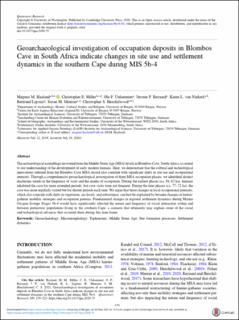Geoarchaeological investigation of occupation deposits in Blombos Cave in South Africa indicate changes in site use and settlement dynamics in the southern Cape during MIS 5b-4
Haaland, Magnus Mathisen; Miller, Christopher E.; Unhammer, Ole Fredrik; Reynard, Jerome P.; Van Niekerk, Karen Loise; Ligouis, Bertrand; Mentzer, Susan M; Henshilwood, Christopher
Journal article, Peer reviewed
Published version

Åpne
Permanent lenke
https://hdl.handle.net/11250/2753987Utgivelsesdato
2021Metadata
Vis full innførselSamlinger
Sammendrag
The archaeological assemblage recovered from the Middle Stone Age (MSA) levels in Blombos Cave, South Africa, is central to our understanding of the development of early modern humans. Here, we demonstrate that the cultural and technological innovations inferred from the Blombos Cave MSA record also correlate with significant shifts in site use and occupational intensity. Through a comprehensive geoarchaeological investigation of three MSA occupation phases, we identified distinct diachronic trends in the frequency of visits and the modes of occupation. During the earliest phases (ca. 88–82 ka), humans inhabited the cave for more extended periods, but cave visits were not frequent. During the later phases (ca. 77–72 ka), the cave was more regularly visited but for shorter periods each time. We argue that these changes in local occupational intensity, which also coincide with shifts in vegetation, sea levels, and subsistence, can best be explained by broader changes in hunter-gatherer mobility strategies and occupation patterns. Fundamental changes in regional settlement dynamics during Marine Oxygen Isotope Stages 5b-4 would have significantly affected the nature and frequency of social interaction within and between prehistoric populations living in the southern Cape, a scenario that ultimately may explain some of the social and technological advances that occurred there during this time frame.
